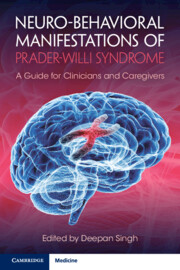Book contents
- Neuro-behavioral Manifestations of Prader-Willi Syndrome
- Neuro-behavioral Manifestations of Prader-Willi Syndrome
- Copyright page
- Dedication
- Contents
- Contributors
- Preface
- Acknowledgments
- Chapter 1 Knowing Your Patient
- Chapter 2 Caregiver Burden in Prader-Willi Syndrome
- Chapter 3 Establishing a Relationship with a Mental Healthcare Provider
- Chapter 4 Sleep Disorders in Prader-Willi Syndrome
- Chapter 5 Autism in Prader-Willi Syndrome
- Chapter 6 Anxiety in Prader-Willi Syndrome
- Chapter 7 Picking, Hoarding, and Elopement in Prader-Willi Syndrome
- Chapter 8 Attention-Deficit/Hyperactivity Disorder in Prader-Willi Syndrome
- Chapter 9 Agitation and Aggression in Prader-Willi Syndrome
- Chapter 10 Mood Disorders in Prader-Willi Syndrome
- Chapter 11 Psychotic Disorders in Prader-Willi Syndrome
- Chapter 12 Psychopharmacology in Prader-Willi Syndrome
- Chapter 13 A Caregiver’s Perspective
- Chapter 14 The Neurobiology of Prader-Willi Syndrome
- Chapter 15 Final Reflections on the Neuro-behavioral Manifestations of Prader-Willi Syndrome
- Index
- References
Chapter 7 - Picking, Hoarding, and Elopement in Prader-Willi Syndrome
Published online by Cambridge University Press: 26 May 2022
- Neuro-behavioral Manifestations of Prader-Willi Syndrome
- Neuro-behavioral Manifestations of Prader-Willi Syndrome
- Copyright page
- Dedication
- Contents
- Contributors
- Preface
- Acknowledgments
- Chapter 1 Knowing Your Patient
- Chapter 2 Caregiver Burden in Prader-Willi Syndrome
- Chapter 3 Establishing a Relationship with a Mental Healthcare Provider
- Chapter 4 Sleep Disorders in Prader-Willi Syndrome
- Chapter 5 Autism in Prader-Willi Syndrome
- Chapter 6 Anxiety in Prader-Willi Syndrome
- Chapter 7 Picking, Hoarding, and Elopement in Prader-Willi Syndrome
- Chapter 8 Attention-Deficit/Hyperactivity Disorder in Prader-Willi Syndrome
- Chapter 9 Agitation and Aggression in Prader-Willi Syndrome
- Chapter 10 Mood Disorders in Prader-Willi Syndrome
- Chapter 11 Psychotic Disorders in Prader-Willi Syndrome
- Chapter 12 Psychopharmacology in Prader-Willi Syndrome
- Chapter 13 A Caregiver’s Perspective
- Chapter 14 The Neurobiology of Prader-Willi Syndrome
- Chapter 15 Final Reflections on the Neuro-behavioral Manifestations of Prader-Willi Syndrome
- Index
- References
Summary
Skin or rectal picking, hoarding of nonfood items, and elopement are common behavioral manifestations in PWS. Early recognition and management of excoriation behaviors by redirection and distraction can help reduce picking behavior. If behavioral interventions including habit-reversal training are ineffective, medication management should be considered. N-Acetyl Cysteine (NAC), topiramate, guanfacine extended-release, and naltrexone are some of the medicines used to manage picking behaviors. Hoarding of nonfood items is another common behavior in PWS that can lead to significant distress to caregivers. The evidence of medications in the management of hoarding in PWS is limited but behavioral management strategies are discussed. Medications may be considered when attempts to limit hoarding leads to aggressive outbursts. Finally, elopement or runaway behavior can be dangerous and potentially life threatening in PWS. In addition to ensuring security and preventing the act of running away, the underlying causes of the behavior whether psychosocial or psychiatric should be explored and treated appropriately.
Keywords
- Type
- Chapter
- Information
- Neuro-behavioral Manifestations of Prader-Willi SyndromeA Guide for Clinicians and Caregivers, pp. 58 - 67Publisher: Cambridge University PressPrint publication year: 2022



